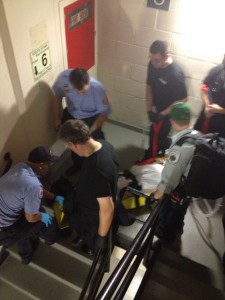Bellevue and the Hurricane
 by Danielle Ofri
by Danielle Ofri
New England Journal of Medicine
When a snarling Hurricane Sandy knocked the lights out at Bellevue Hospital Center on that Monday night, the staff murmured a collective chant: “One-Mississippi, two-Mississippi, three-Mississippi…” We’d been told that if the electricity came back on before we hit “ten-Mississippi,” then the backup generators were working fine. A communal sigh was heaved when the count stopped short of double digits. Ventilators and intravenous (IV) pumps hummed on without a hitch. Downstairs, however, water was pouring into the basement, inundating the elevator shafts and disabling all 32 elevators.
At 10 p.m., it was realized that the basement fuel pumps were submerged and could not bring fuel to the emergency generator on the 13th floor. If that generator tank was not replenished by midnight, all power to the hospital would be lost. Oxygen tanks and interns were stationed at the bedside of every patient on a ventilator, just in case. Nonessential electricity was turned off. Any IV drip that could be converted to subcutaneous injection was changed. The collective pulse of the staff notched up toward tachycardic, though externally everyone remained focused and calm.
Within the hour, a fuel truck from the New York Police Department showed up at the entrance to the emergency department. An impromptu bucket brigade was formed: 5-gallon jugs were filled from the truck and then passed, hand to hand, from maintenance workers to facilities managers to doctors, technicians, and clerical staff who lined the darkened stairwell. Within 2 hours, 500 gallons of fuel had been lugged up to the 13th floor until the generator tank was full. Electrical power never faltered again for the duration of the crisis.
There was another ticking clock, however–the water supply. Rooftop tanks feed the hospital by means of gravity. But the pumps that haul the water 200 feet up to those tanks had been damaged by the flooding. The tanks held about a day’s worth of water–enough to last until Tuesday evening. There was still hope that the pumps could be repaired soon, enabling the water system to function, so a full-scale evacuation was not yet initiated. Nevertheless, the bulk of the day on Tuesday was devoted to transferring patients who were at high risk to other New York City hospitals in case the situation did not improve. One by one, all the patients in the intensive care unit, those on ventilators, and those receiving hemodialysis were carried down the stairs by emergency medical technicians and taken to local hospitals. Late on Tuesday, however, the water pressure began to diminish, and by evening the water supply had run out. National Guard troops had arrived and were jogging tanks of water upstairs, but it was impossible to keep up with the water needs. When 1000 toilets stop flushing–well, let’s just say that the tenor of life is altered.
The most intractable problem on an operations level was the lack of access to the basement to attempt repairs. Water levels were 6 ft in most places, but up to 14 ft on the loading docks. Emergency teams were pumping water out of the basement as fast as they could, but progress was slow. The repair shops, elevator bases, and fuel pumps were all under water.
Upstairs, medical care was proceeding surprisingly smoothly. Medications were administered. Laboratory testing continued. The pharmacy kept the floors supplied with medications. Runners were posted on every floor to ferry messages and supplies. And this being Manhattan, deliveries of pizza and Chinese take-out food never flagged–though it was the doctors, nurses, and medical assistants who had to carry it up 17 flights of stairs.
Evacuation plans were discussed throughout the night on Tuesday, and coordination began Wednesday morning. Priority lists were generated by each clinical service. Administrators coordinated efforts between hospitals. Ambulances from all over the country lined up by the entrance. The National Guard was mobilized to undertake the heavy lifting.
 What transpired next can only be described as breathtaking. There was certainly tension in the air, but the evacuation was smooth, calm, and orderly. Intense clinical preparation preceded each patient’s exit. The sickest patients were brought down first. Then the hospital was evacuated ward by ward into the early hours of Wednesday morning. Patients who couldn’t walk were carried down on sleds by the National Guard troops, accompanied by medical chaperones.
What transpired next can only be described as breathtaking. There was certainly tension in the air, but the evacuation was smooth, calm, and orderly. Intense clinical preparation preceded each patient’s exit. The sickest patients were brought down first. Then the hospital was evacuated ward by ward into the early hours of Wednesday morning. Patients who couldn’t walk were carried down on sleds by the National Guard troops, accompanied by medical chaperones.
At the ground floor, each patient was met by a medical team. Discharge instructions, clinical status, and transfer plans were rechecked. This process encompassed everyone from neonates to the elderly, psychiatric patients, pregnant patients, numerous patients who spoke no English, and prisoners from Rikers Island, from both the medical–surgical and psychiatric forensic wards.
By the time the operation was finished on Thursday morning, only two patients remained in the hospital. Their medical conditions necessitated an elevator for safe transport. These patients were cared for in-house while emergency repair crews pumped some 10 million gallons of seawater out of the basement.
By Friday, workers could enter the basement to assess damage and begin repairs. Within 36 hours, one elevator was rehabilitated, and the last two patients were safely evacuated. By 6:30 p.m. on Saturday, November 3, Bellevue was empty of patients–probably for the first time since it opened its doors on March 31, 1736.
The night after the bulk of the patients had been evacuated, I walked past the hospital. Lower Manhattan was still without power, and First Avenue was eerily black. Bellevue sat dark and silent, like a hulking Henry Moore sculpture. It suddenly looked so fragile to me, so forlorn.
Bellevue’s enormity is more than its imposing physical presence, more than its legacy as the oldest public hospital in the country, more than its outsized reputation in popular culture. Its grandeur resides in its status as a living, breathing medical organism. It possesses a gritty industriousness and a cacophonous vitality. The ferocious loyalty it has engendered for the past 276 years is apparent in its staff as well as its patients. Many of us have spent our entire working lives at Bellevue and couldn’t imagine being anywhere else.
The preternatural quiet of the hospital was unnerving. But the overwhelming feeling was one of sadness. Grief, really. The adrenaline surge of the evacuation had receded, and we were all left grieving–for our scattered patients, for our disrupted educational programs, for our stilled hospital.
The 4000 faculty and staff members, residents, and medical students of Bellevue have been dispersed throughout the five boroughs, taking care of our inpatients, struggling to care for our tens of thousands of outpatients. The generosity of spirit from the hosting hospitals, our peripatetic patients, and our coworkers has been boundless. But without our nexus of Bellevue to knit us together, we feel unmoored. When a hospital is forced to halt, it’s not just the patients who are evacuated.
 Everyone is justly proud of the remarkable feat that occurred during the hurricane. The selfless and seamless cooperation among clinicians, administrators, staff members, facilities workers, National Guard troops, and emergency officials was nothing short of extraordinary. Every single patient was safely and smoothly transferred. Repair crews are working feverishly to repair the damage, and we expect to have some of the Bellevue clinics running within a few weeks. But it is hard to restrain our heartache at seeing this grande dame of hospitals drained of its lifeblood of medical activity.
Everyone is justly proud of the remarkable feat that occurred during the hurricane. The selfless and seamless cooperation among clinicians, administrators, staff members, facilities workers, National Guard troops, and emergency officials was nothing short of extraordinary. Every single patient was safely and smoothly transferred. Repair crews are working feverishly to repair the damage, and we expect to have some of the Bellevue clinics running within a few weeks. But it is hard to restrain our heartache at seeing this grande dame of hospitals drained of its lifeblood of medical activity.
*A special thanks to all of the Bellevue staff who shared their stories for this article.*
